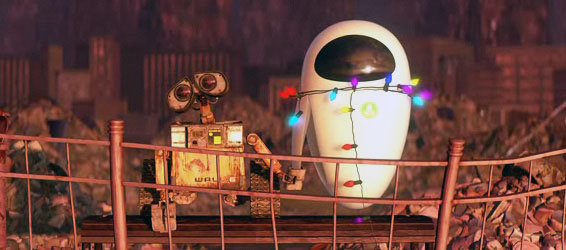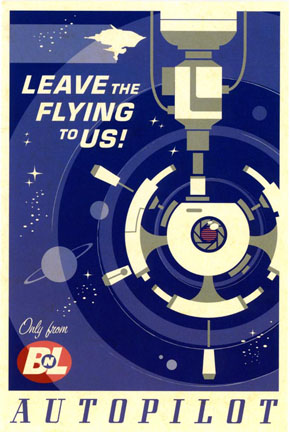

|
Or, perhaps it was Stanton's intention to create the gender binary in order to skew culturally sedimented notions of the masculine and the feminine. Conventional forms of psychoanalysis in film will help to dissect how exactly we give robots, who look nothing like humans, genders. I will focus on the visual construction of Wall-e and Eve through a simple movie poster. Then I will talk about how, although we are given conventional forms of masculinity and femininity, these genderized robots do not necessarily pursue the hegemonic understanding of masculinity and femininity as we know it. I believe the robots were given gender simply so a human audience can identify with the protagonists of the film, become close to them and in a way becomes them. Baudry gave a name to this called the "cinematic apparatus" where "the spectator, 'the eye subject' is the "center of vision" (Creed 77). The audience identifies with the subject being viewed, making themselves the subjects they are viewing, which very closely relates to the idea of appellation I talked about in the Visuality of Robots section. In the next section then, I will talk about how the antagonist, Auto, in this film creates a foil to robots who discover humanity, how the nemesis of this film is culturally sedimented in film to represent a certain paranoia about human technology and the potentiality of total robotic control and the absolute suppression of human curiosity. |
| We don't even have to watch the movie to see how Wall-e and Eve become male and female. The framing of the poster to the right helps to indicate the gender difference between these two robots, both "connecting" and "disconnecting" these "elements" (Jewitt and Oyama 148). Wall-e, on the left, represents this rough, boxy type, an older model of robot who works a labor- intensive, strength-oriented task, and he is the "given." The film opens with Wall-e. It constructs him as those things (we can't get all of that information I just gave about him from the poster.) Eve, on the right, is the new. We can see that she is newer than Wall-e, a more elegant model and the object of Wall-e's desire. These two objects are separated because of their physical distance, because of their design difference and because of their body orientations. The vectors of their gazes do not align. At the same time though, we know they are also connected in ways that are important to the film itself. "In a world ordered by sexual imbalance, pleasure in looking has been split between active/male and passive/female"(Mulvey 62). Wall-e's gaze is active, it seeks rather than sees while Eve's line of site is not active, rather it denotes passivity. The orientation of Eve's body towards Wall-e as she laughs as well as his hopeful gaze conveyed by his clasped hands and line of site suggest a relationship between these two objects, the given and the new. If the gestures enacted by the robots were not enough in the movie poster, the "marginal" components of the image add to it as well. The bench lends itself to the spatial relationship between the actors, seeing as it confines to the same point of view for the audience. The robots are placed on the same plane of existence so as not to express one as more or less superior than the other. The full moon, with the bench and the lamp all together can be construed as symbols of a romantic setting. |

|

|
Now, this was all derived visually from the promotional movie poster without knowing the names of the two robots in the poster. Another poster, the one on the left, actually has text that labels the image of Wall-e as a he, stating "After 700 years of doing what he was built for, he'll discover what he was meant for." So, we are meant to know Wall-e's sexuality before we even start the film, before we know anything else about the robot. In the film itself, if we had never seen any of the promotional work done for the film, however unlikely that may be, male and female are determined in one simple episode when Wall-e and Eve exchange a very limited but very telling verbal communication. Wall-e labels himself in an obviously masculinised voice with his relatively masculine name. Eve does the same, labeling herself in a feminine voice with a feminine name. If there had been no audible communication between these two robots, I guess one could argue how their physically constructed bodies come off gendered, as I stated above in the semiotic analysis of the movie poster. Yet, Eve's "construction" as feminine is constantly interrupted and in jeopardy, as she potentially representing the "non-castrated [woman]" (Rose 122 -123). |
 |
When Eve is incapacitated by her directive, going into a hibernation state, we see Wall-e carry out his fantasy towards her. Wall-e has seen from the Hello, Dolly! film his desire, or "the pleasure gained from fantasizing about lost objects" (Rose 131). Eve, incapacitated by some inner programming, becomes the unwilling subject of Wall-e's desire and focus. Although he takes care of Eve during her catatonic state, Wall-e also constructs her as he would want to see her ideally. Wall-e dresses Eve up, forcing her to done "the mask of femininity" (Rose 124). Like we see here, he decorates her, and then eventually we see him trying to perform with her the act that he thinks is the ultimate, the pinnacle of his fetishistic desire - holding hands. In a way Wall-e is forcing himself onto Eve, assuming she would have no objections to his desire to hold her hand. |  |
| At the same time however, we do see a moment when Eve carries out her own construction of femininity, separate from and free of Wall-e's desired ministrations. Wall-e lost Eve in her incapacitated form, "where a restoration is promised - not through a heroic return, however, but through the liberations of a lover into the discourse of restoration...[but at the] loss and the impossibility to an unproblematized 'real'"(Gilmore 151). Eve is "restored" and pampered by the what assimilates a beauty shop, where she basically performs femininity and allows it to be performed on her. Wall-e has lost the unproblematized Eve, one uninterested in her directive and unobjectionable to Wall-e's advances. It is interesting that Wall-e does not see Eve's construction of feminism as just that, femininity. Instead, he misconstrues and assumes the ship is disassembling his love interest before him. Thus, Wall-e in an act of desperation castrates Eve himself, stealing her arm and trying to use the phallus (her gun) as a tool to reclaim his lost love interest. When given the power of masculinity, Wall-e did not understand how to facilitate that power and facilitate it against the hegemonic construction of the Axiom. Wall-e never had any intention of firing Eve's arm, but his incompetence triggered what would eventually be the downfall of the hegemony in place on the Axiom, that of the ethical robot. Wall-e is not like Jimmy Stewart in any of Alfred Hitchcock's films about scopophilia and the male gaze and fetishistic voyeurism. He doesn't have a desire to own or posses Eve. Wall-e portrays what I believe a new perspective on the heterosexual relationship in today's cinema, that of an equally mutual relationship between two people who like one another and hold each other in respect. We see Wall-e desperately seek how to wake Eve up, resurrect her, and when that fails, we see him both simultaneously serve her and posses her and force his ideal image of femininity onto her. When Wall-e was trying to force the unresponsive Eve to hold his hand, it is seen as pathetic and unappealing, especially when we see him struck over and over again by lightning, in comparison to the 'kiss' Eve willingly gives to Wall-e. |  |
Either follow the image below to navigate the Axiom and its hegemonic power structures or go back either to the Semiotic of Hello, Dolly! or return to Visualizing Humanity.
| Navigating the Axiom | Back to the Semiotics of Hello, Dolly! | Back to Visualizing Humanity |

|

|

|